Your cart is currently empty!
Author: Coyote Outdoor

The Fire and the Hand Test
Controlling the heat of your fire is the first rule of grilling, and the most reliable and time-honored method of testing the heat of your fire is not an expensive gadget: it’s your hand.
And, no, we’re not suggesting you actually touch the fire or the grate to see if it’s hot. (Grillmaster Tip: If anyone tells you to touch fire, don’t do it- ok?)
But the next time your grill is heating, DO hold your hand OVER the grate and your urge to move your hand away will be your measurement tool.
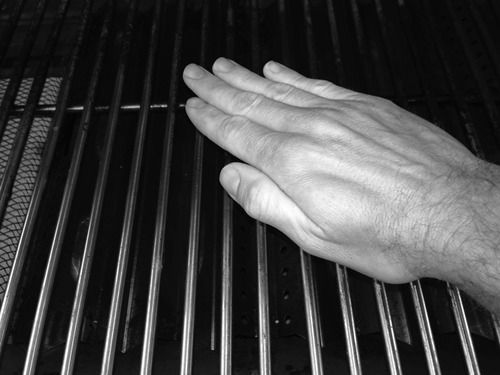
After starting up the burners, hold your hand 1 to 2 inches over the grate, and you’ll be able to approximate the heat level.
If the radiating heat makes you move your hand away in 1-2 seconds, you’ve got a fire at high heat.
If you move your hand away in 3 seconds, you’re at a medium-high temperature.
If you move your hand away in 4-5 seconds, you’ve got a moderate fire.
Try “The Fire and the Hand Test” before you put food on the grate for grilling, and you’ll be an ‘old hand’ at this – knowing your grill’s temperature – before long.
Happy grilling!

Coyote Centaur Hybrid Grill highlighted as ‘Top Gear’ in Food & Wine Magazine
Look for the all new Centaur 50” Hybrid Gas and Charcoal Split Hood Grill in the June issue of Food & Wine Magazine.
The Centaur features two outdoor cooking options – both grilling and smoking – in one. For more details on the Centaur Hybrid click here.
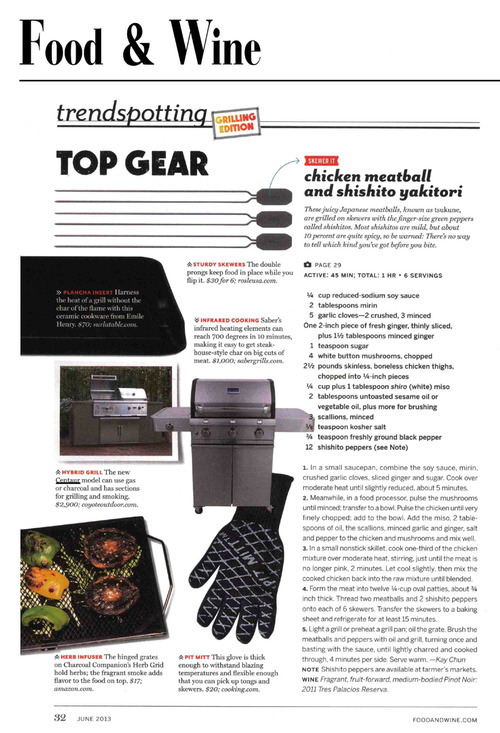

The “7-6-5” Method: Foolproof Grilled Pork Tenderloin
A simple way to remember appropriate grilling times for pork tenderloin from this article in Fine Cooking (full recipe here).
“The “7-6-5” method for grilling pork tenderloin refers to the amount of time each side gets, with the burners on high heat: seven minutes on the first side, six minutes on the second side, and then five minutes with the grill turned off and the lid closed. The method is so reliable that I can set a timer and go about my business.“
We tested the method on the Coyote 34 inch C-Series Grill and the tenderloin came out great.
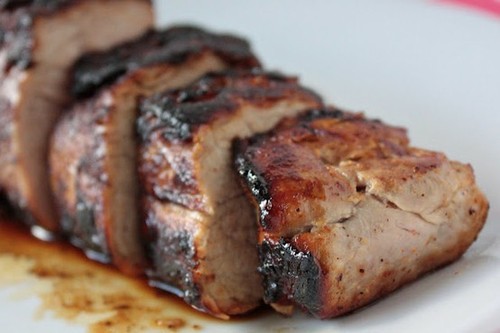
Every time we turned the pork, we poured beer over the tenderloin. Just enough to keep it moist.
And before the last 5 minutes of grilling, we rolled the tenderloin in pan of a glaze made from 1 can of cranberry sauce, ¾ cup of strawberry preserves, 1 tablespoon of garlic powder, and salt and pepper.
Total prep and grilling time: 25 minutes. The “7-6-5” Method is definitely a good rule of thumb for low stress grilling for perfectly cooked pork tenderloin!

Visual Guide to Grilling Times and Temperatures
There are 3 key questions for every food you prepare on the grill:
- Should you grill with low heat or high heat?
- Direct heat or indirect heat?
- How long to cook?
Here’s a good visual reference created by VisualNews in 2013 to help you answer these 3 questions. It’s a guide to grilling times and temperatures for beef, chicken, pork, seafood, and vegetables.
Click here for the full size guide.


California-Style Grilled Tri-Tip or “Santa Maria” Steak
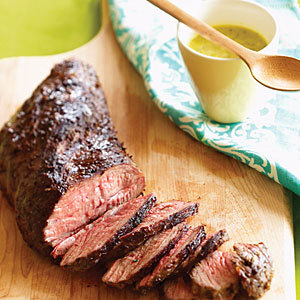
The tri-tip is a cut of beef from the bottom sirloin primal cut.
Often labeled “Santa Maria steak”, the roast is most popular in the Central Coast of California and Central Valley regions of California, and has begun to enjoy increasing favor elsewhere for its full flavor, lower fat content, and comparatively lower cost.
Here’s a recipe for tri-tip with an Oregon-inspired herb rub:
Grilled Tri-Tip with Oregon Herb Rub
- 1 tablespoon salt
- 1 ½ teaspoons garlic salt
- ½ teaspoon celery salt
- ¼ teaspoon ground black pepper
- ¼ teaspoon onion powder
- ¼ teaspoon paprika
- ¼ teaspoon dried dill
- ¼ teaspoon dried sage
- ¼ teaspoon crushed dried rosemary
- 1 (2 ½ pound) beef tri-tip roast
Directions
- Mix together the salt, garlic salt, celery salt, black pepper, onion powder, paprika, dill, sage, and rosemary in a bowl. Store in an airtight container at room temperature until ready to use.
- Use a damp towel to lightly moisten the roast with water, then pat with the prepared rub. Refrigerate for a minimum of 2 hours, up to overnight, for the flavors to fully come together.
- Preheat an outdoor grill for high heat and lightly oil grate.
- Place the roast onto the preheated grill and quickly cook until brown on all sides to sear the meat, then remove. Reset the grill for medium-low indirect heat (if using charcoal, move coals to the outside edges of the grill pit).
- Return the roast to the grill, and cook, turning occasionally, until the desired degree of doneness has been reached, about 1 ½ hours for medium-well. Remove from the grill and cover with aluminum foil. Allow to rest for 10 minutes before carving across the grain in thin slices to serve.
Pair with a Chico- California made Sierra Nevada Pale Ale to do dinner tonight the West Coast way.
Cheers!

The United States of Barbecue: Guide to Four Major Regional Styles
Travel around the United States, and you will find that “barbecue” means many things to many people, depending on where you are standing.

Most grillmasters agree that AT LEAST four major regional styles exist:
- Memphis
- Carolina
- Kansas City
- Texas
Memphis-style barbecue– primarily two different dishes: ribs, which come “wet” and “dry”, and barbecue sandwiches. Wet ribs are brushed with sauce before and after cooking, and dry ribs are seasoned with a dry rub.
Carolina barbecue– usually pork, served pulled, shredded, or chopped, but sometimes sliced. It may also be rubbed with a spice mixture before smoking and mopped with a spice and vinegar liquid during smoking.
Kansas City- has a wide variety in meat, but the signature ingredient is the sauce. The meat is smoked with a dry rub, and the sauce served as a table sauce. Kansas City style sauce is typically thick and sweet based on tomatoes and molasses.
Texas- there are four generally recognized regional styles of barbecue in Texas:
- East Texas style, which is essentially Southern barbecue and is also found in many urban areas;
- Central Texas “meat market style,” which originated in the butcher shops of German and Czech immigrants to the region;
- West Texas “cowboy style,” which involves direct cooking over mesquite and uses goat and mutton as well as beef; and
- South Texas barbacoa, in which the head of a cow is cooked (originally underground).
To read more on regional traditions in barbecue, check out this article, “The United States of Barbecue” in Saveur Magazine.

Baby Back Ribs with a Colorado Twist
Colorado, the 38th state to join the Union in 1876, encompasses most of the Southern Rocky Mountains and holds the spotlight in this week’s 50 States / 50 Grill Recipes / 50 Beers feature.

Of course, Colorado is also home to some of the nation’s most esteemed beers, including many by the legendary Golden-based brewer Coors, and many by innovative and influential craft brewers, including New Belgium Brewing of Fort Collins.
Here is a recipe from Tony’s Market that pulls together the flagship brew by New Belgium, Fat Tire, to create the barbecue sauce for a backyard grilling classic, Baby Back Ribs.
Use the “slow and low” indirect grilling method, that is, with one hot zone and one cool zone, and close the lid of the grill to cook the ribs at a temperature of around 300 degrees for 60-90 minutes.
See the complete recipe here and pull together:
- 1-2 racks baby back ribs
- your favorite prepared BBQ seasoning rub
Fat Tire BBQ Sauce:
- 1 Fat Tire beer
- ¼-cup chile sauce
- 2 TBS Sundried tomato paste
- 3 TBS brown sugar
- 1 tsp Cajun or other southwestern seasoning
- ¾-1 tsp liquid smoke (optional)
- ¼ tsp Coleman’s Mustard
- ¼ tsp hot sauce
And grab a six pack of the Fat Tire because you and your grilling assistants will need refreshment for the 60-90 minutes of low and slow grilling on your Coyote Grill.
Cheers and happy grilling!
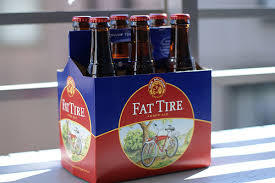

Backyard Oktoberfest
Oktoberfest is the world’s largest fair, a 16-day festival held in Munich, Germany since 1810. More than 6 million people attend the annual celebration to drink 7 million liters of beer and eat traditional German foods.
Bratwurst and sausage are Bavarian traditions, and Americans continue to rely on the “brat,” as a classic for tailgate and backyard get togethers.
Oktoberfest ended on October 7 in Munich, but with fall’s cooler temperatures, perfect for outdoor get togethers, why not host your own mini-Oktoberfest with grilled brats and beer?
Grilling guru Stephen Raichlan has good advice for grilling brats, cautioning that “a burnt brat is an unfortunate sign of impatience.”
The key to grilling a highly flammable food like sausage is to use moderate heat and grill slowly…
To achieve expert brat status I recommend a “low and slow” approach. That means grilling brats on a moderate flame until the internal temperature reaches 170 degrees, about 25 minutes, or the time it takes to relax with a cold beer.
Sounds like a good time to use the “indirect grilling” or “two zone” method, with one side of the grill on high or medium heat and the bratwurst and sausage other side of the grill on a low heat setting.
Close the grill cover as needed, but watch the outside of the skin and remember that burnt or split skins is to be avoided.
As for beer pairings, pick up any one of the great seasonal Oktoberfest beers you see in stores, including fine ones by Paulaner, New Belgium, Leinenkugels, Samuel Adams, and Shiner.

Happy grilling and prost!

Big Sky Country Grilled Trout
For the Montana edition of 50 States/ 50 Grill Recipes/ 50 Beers, we’ve got a recipe for grilled trout that will bring a little of the Big Sky Country to your Coyote Outdoor kitchen-
Seasoned fly fisherman know that some of the best trout fly fishing rivers on earth are within the borders of Montana, the 41st state in the Union.
Whether your trout comes from a recent fishing trip or the market, here’s a recipe for grilled trout that you can knock out in 35 minutes in the backyard, and best of all, you can drink what’s leftover of one of the ingredients, the Missoula, Montana-brewed Moose Drool Brown Ale.
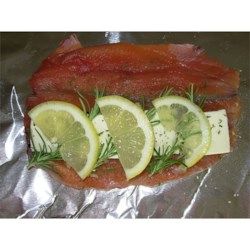
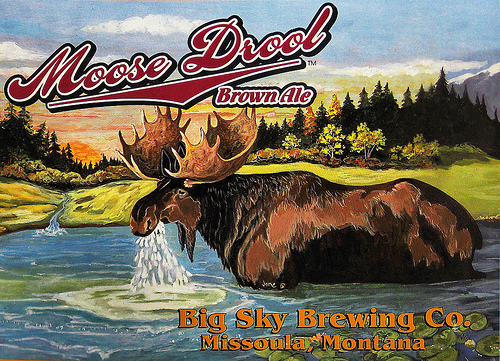
Pull together:
- 2 trout, cleaned and head removed
- 3 tablespoons cold butter, thinly sliced
- 6 sprigs fresh rosemary
- ½ teaspoon chopped fresh rosemary
- 1 teaspoon chopped fresh parsley
- salt and pepper to taste
- 2 cloves garlic, minced
- 2 tablespoons Moose Drool brown ale (or any dark beer on hand)
The full recipe text is here and directions are below:Directions
- Place each trout onto a square of aluminum foil. Open them up so that the flesh is facing upwards. On one side of each fish, season with salt and pepper, half of the garlic, half of the chopped rosemary and half of the parsley. Top each fish with thin slices of butter, 1 tablespoon of beer, 3 rosemary sprigs and a few slices of lemon. Squeeze one of the remaining lemon slices over each fish. Enclose the seasoning inside each fish and wrap securely with the sheet of aluminum foil. Wrap each fish in an additional piece of aluminum foil.
- Place fish in the coals of a campfire or on a grill over a flame and cook for about 7 minutes on each side. If you can easily stick a fork into the fish, it is done. Cooking time will vary depending on the size of your fish and the fire. Allow to cool for a few minutes before opening to serve.

Washington: Grilled Pacific Halibut with Raspberries
To represent the 42nd state to join the Union, Washington, we’ve pulled together a recipe for grilled halibut with a side of fresh raspberries.
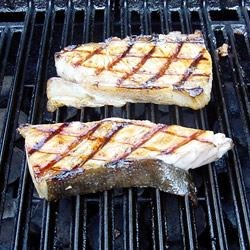
The Pacific halibut is found in the waters of the North Pacific Ocean, and commercial halibut fishing actually began off the coast of Washington in 1888.
On top of that, 90% of red raspberry production in the U.S. came from Washington state, so our 50 States/50 Grill Recipes/50 Beers feature this week brings together halibut and raspberries in a quick and healthy dish you can have ready in 25 minutes on any weeknight on your Coyote Outdoor kitchen.
For this grilled halibut recipe, pull together:
- 2 tablespoons butter
- 2 tablespoons brown sugar
- 2 cloves garlic, minced
- 1 tablespoon lemon juice
- 2 teaspoons soy sauce
- ½ teaspoon ground black pepper
- 1 (1 pound) halibut steak
And as for the raspberry finish, just add a few fresh raspberries to the top of the grilled halibut upon serving, for a sweet and tart pairing.
Finally, don’t forget a Redhook Pilsner (brewed in Woodlinville, Washington) for a refreshing contrast to the sweetness of the brown sugar and berries.
Cheers and happy grilling!
